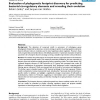Free Online Productivity Tools
i2Speak
i2Symbol
i2OCR
iTex2Img
iWeb2Print
iWeb2Shot
i2Type
iPdf2Split
iPdf2Merge
i2Bopomofo
i2Arabic
i2Style
i2Image
i2PDF
iLatex2Rtf
Sci2ools
BMCBI
2008
2008
Evaluation of phylogenetic footprint discovery for predicting bacterial cis-regulatory elements and revealing their evolution
Background: The detection of conserved motifs in promoters of orthologous genes (phylogenetic footprints) has become a common strategy to predict cis-acting regulatory elements. Several software tools are routinely used to raise hypotheses about regulation. However, these tools are generally used as black boxes, with default parameters. A systematic evaluation of optimal parameters for a footprint discovery strategy can bring a sizeable improvement to the predictions. Results: We evaluate the performances of a footprint discovery approach based on the detection of over-represented spaced motifs. This method is particularly suitable for (but not restricted to) Bacteria, since such motifs are typically bound by factors containing a Helix-Turn-Helix domain. We evaluated footprint discovery in 368 Escherichia coli K12 genes with annotated sites, under 40 different combinations of parameters (taxonomical level, background model, organism-specific filtering, operon inference). Motifs are as...
| Added | 08 Dec 2010 |
| Updated | 08 Dec 2010 |
| Type | Journal |
| Year | 2008 |
| Where | BMCBI |
| Authors | Rekin's Janky, Jacques van Helden |
Comments (0)

